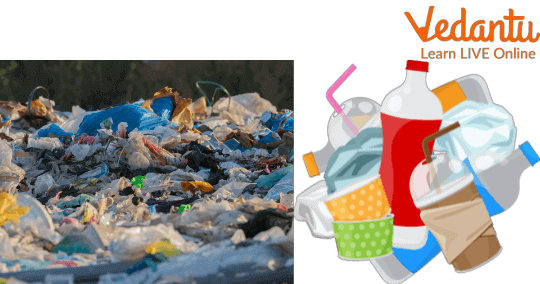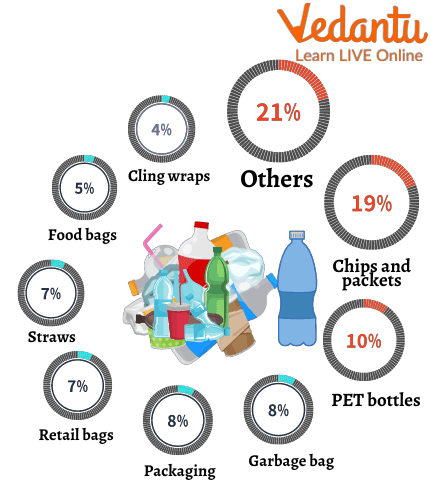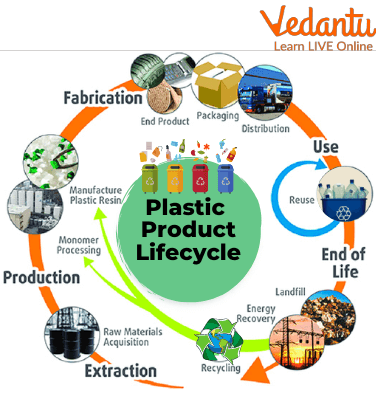




Why Understanding Plastics Matters in Our Daily Lives
Plastic is a material that has been used for many years. It is not just a material that we use to make toys, it is also used in many other aspects of our lives. Plastic is usually made from fossil fuels such as oil or natural gas. These raw materials are heated to very high temperatures and mixed with other chemicals to create the different types of plastics we use every day.
In this article, we will read about the properties, uses of plastics. We will also discuss plastic facts for kids. So, without wasting time, let’s start learning.

Recycling of Plastic
Uses of Plastic
Plastic has many uses in the modern world, ranging from everyday items to dental implants.

Number of Places Where Plastic is Used
From food packaging to medical equipment, plastic is being used in every aspect of our lives. The plastic is commonly used by kids via toys,bottles,and tiffin boxes.Plastic has been used to make containers, bottles, and many other items that we use every day. But the problem with plastic is that it doesn’t break down easily and can take up to 1000 years to decompose.
It has been estimated that around 8 million tons of plastic are produced each year, and that more than half of it is thrown away after a single use. This poses a huge problem to the environment as it ends up in landfills or makes its way into our oceans and rivers, where it can remain for centuries before breaking down into tiny pieces.
We should make sure we are recycling as much as possible and using less plastic in our day-to-day lives.
Properties of Plastic
Plastic is a material that is made of a mix of organic and synthetic substances.
It is man-made and it has many properties.
Plastic is a material consisting of polymers of high molecular mass. It is typically a synthetic material made from petrochemicals, such as oil or natural gas.
The properties of plastic are similar to those of other synthetic polymers, and it usually has a high melting point, low water solubility and good chemical resistance.
Application of Plastic

Application Applied on Plastic to Use
Television, phones etc. are durable, not too heavy, and affordable as they are made using plastic. Varieties of sports tools are made using plastic like helmets, mouth guards, goggles, protective pads etc. In this case plastic helps to be sure of safety. Rugged plastic shells that cover helmets and pads help protect heads, joints, and bones from being injured severely.
In the automobile sector ,plastic has improved the performance, safety, and fuel efficiency. In product packaging, plastic aids to protect and preserve goods, and also lessen weight in transportation. This is how it helps in saving fuel and lessens greenhouse gas emissions.
A close check on the amount of plastic bags we use is important because once we dump the plastic bags away,they will just gather and create pollution, which is harmful to the environment. This should be taken into account because the plastic bags, straws, glasses, plates are just single use plastic and are then thrown away which then contributes to the pollution being created. This is how the use of plastic articles affects our everyday life.
Plastic Facts for Kids

How Plastic is Used in Everyday Life in Various Ways
We know that plastic is a huge problem for our environment. We use it, we throw it away, and we don't think about the consequences. The thing is that plastic never really goes away. It's in the oceans and in our food supply. It's time to stop using plastics and start thinking about alternatives.
Some people think that recycling is a good solution to this problem but it actually doesn't work very well. The recycling process requires too much water, energy and money to be worth the effort of collecting all these different types of plastics. Plus, even when plastics are recycled they don't always get turned into something useful like new bottles or bags.
It's time for us to take responsibility for the waste we produce. Most plastics contain two main ingredients: polymers (chains of molecules) and additives (ingredients which give the plastic certain properties).
There are a lot of things that we can do to reduce the amount of plastic in our lives. One way is by using reusable water bottles instead of single-use water bottles. Another way would be by using metal straws instead of plastic straws and finally by refusing single-use plastics when you are out shopping.
Summary
Plastic affects many people, not only the consumers but plastic bags also affect the environment and animals. We are affected by plastic items because we all dispose of them incorrectly and because we are unaware of the consequences of using plastic bags. We should be very careful while disposing of the plastics we have used already, we need to take care of the environment and that could be done only by recycling the plastic items. This article was about plastic and its characteristics. Now, we are aware of the harmful effects of plastic. We hope you enjoyed reading this article, in case of any other doubts, feel free to ask in the comments.
FAQs on Essential Facts About Plastic: Easy Guide for Students
1. What is plastic in simple words for kids?
Plastic is a man-made material that can be moulded into almost any shape. Think of it like a special kind of clay that becomes hard and strong once it's set. It is made from chemicals found in natural resources like oil. Because it is lightweight, strong, and waterproof, we use it for many things, from toys and bottles to chairs and computers.
2. Who invented the first fully synthetic plastic?
The first fully man-made plastic, known as Bakelite, was invented by a Belgian chemist named Leo Baekeland in 1907. He discovered that by mixing certain chemicals and applying heat and pressure, he could create a new, hard, and mouldable material that was unlike anything found in nature.
3. What are some everyday examples of plastic items?
We see and use plastic items all the time. Some common examples include:
- Toys: Building blocks, dolls, and toy cars.
- Kitchenware: Lunch boxes, water bottles, and plates.
- School Supplies: Pens, rulers, and backpacks.
- Furniture: Plastic chairs and tables.
- Packaging: Wrappers for snacks and plastic bags.
4. How does plastic harm our environment?
Plastic harms the environment mainly because it does not decompose, or break down naturally, like a banana peel does. Instead, it stays around for hundreds or even thousands of years. This waste pollutes our land, rivers, and oceans. Animals can mistake small pieces of plastic for food, which can make them very sick.
5. What is the difference between single-use and reusable plastic?
The main difference is how many times we can use them. Single-use plastic is designed to be used only once and then thrown away, like straws, plastic bags, and food wrappers. Reusable plastic is thicker and more durable, designed to be used many times, such as a lunch box, a hard water bottle, or a food storage container.
6. If plastic is harmful, why do we use it for so many things?
We use plastic for many things because it has several useful properties. It is strong but also very light, it is waterproof, and it is inexpensive to produce. These qualities make it ideal for keeping food fresh, creating life-saving medical equipment, and making parts for cars and planes lighter. The problem isn't the material itself, but how we manage its disposal, especially single-use plastics.
7. Why is recycling plastic so important?
Recycling is important because it turns old plastic waste into new, useful items. This process helps in two major ways: first, it reduces the amount of waste that goes into landfills and oceans, which protects wildlife and our environment. Second, it saves natural resources like oil, because it means we don't have to make as much new plastic from scratch.
8. How long does it take for a plastic bottle to break down?
A typical plastic bottle can take around 450 years to decompose in a landfill. Unlike natural materials, it doesn't rot away quickly. It just breaks into smaller and smaller pieces called microplastics, which can remain in the environment for a very long time, polluting soil and water.









